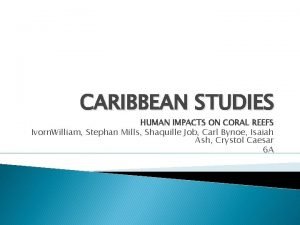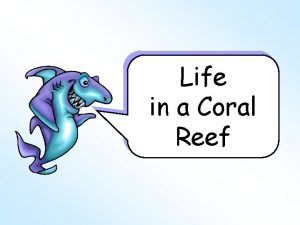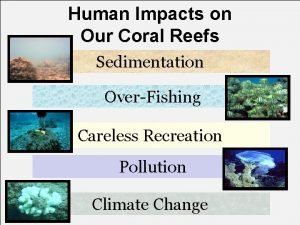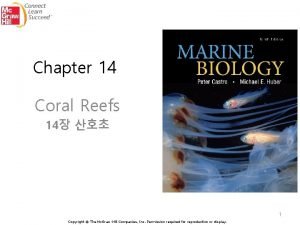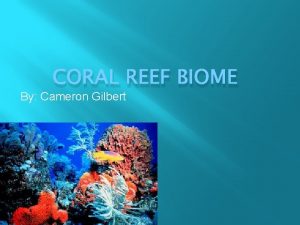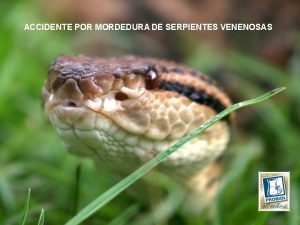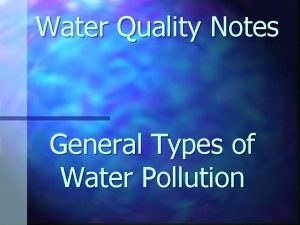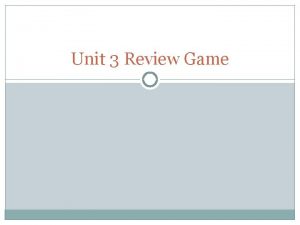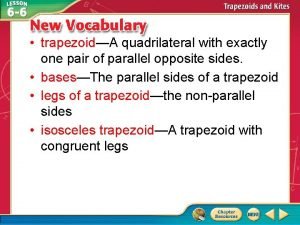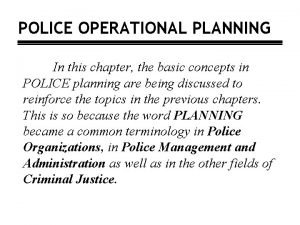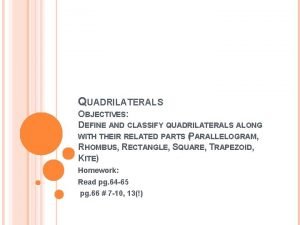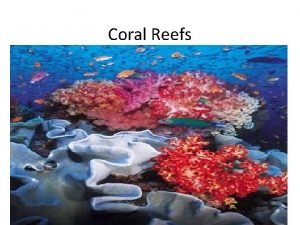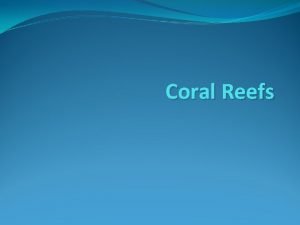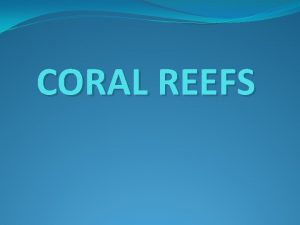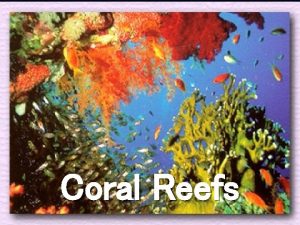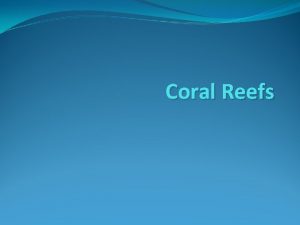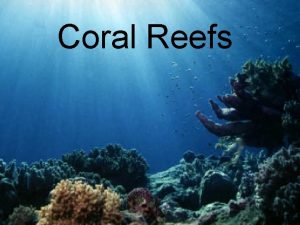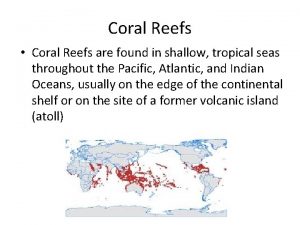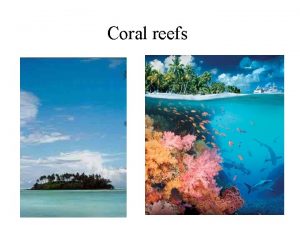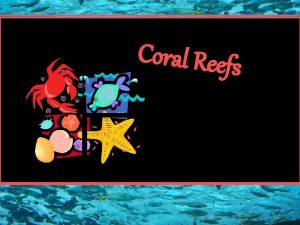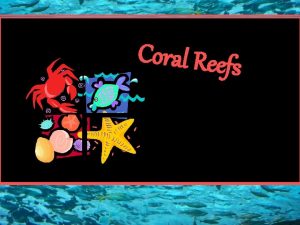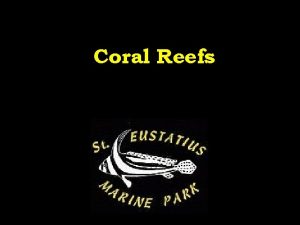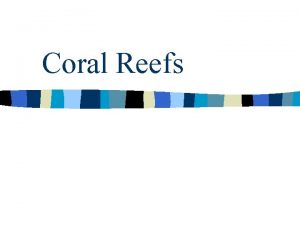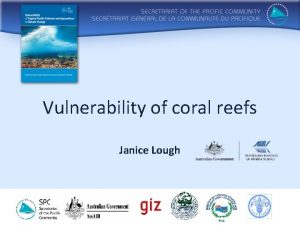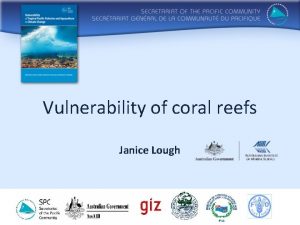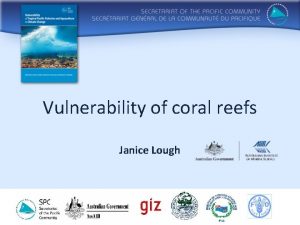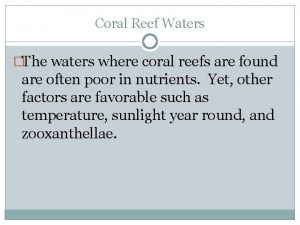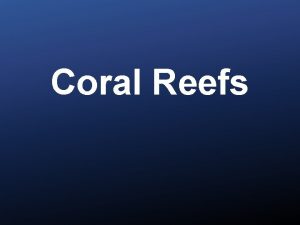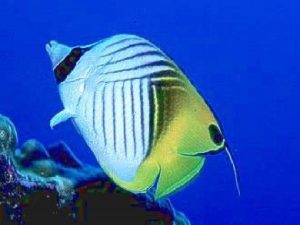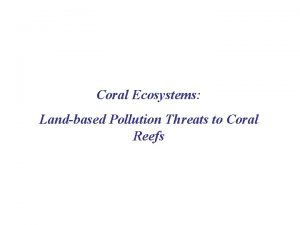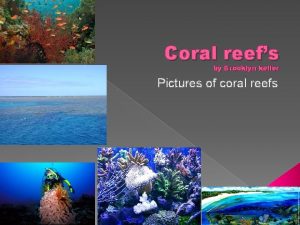Coral Reefs What exactly are coral reefs Coral
























- Slides: 24

Coral Reefs

What exactly are coral reefs? Coral reefs are rocky mounds and ridges formed in the sea by marine organisms through the accumulation and deposition of limestone, otherwise known as calcium carbonate. Coral reefs are unique and rich marine ecosystems. -Hard Coral Colonies: living polyps 1) massive 2) branching 3) plate-like

Ecological Requirements of Coral Reefs �warm water (17 -34°C) �shallow coastal waters and bays �sufficient sunlight to support photosynthesis

Where are coral reefs located? - Pacific Ocean - Atlantic Ocean - Indian Ocean (including the Red Sea) 3 Widely Recognized Major Coral Reef Areas: - Indo-Pacific Region - Wider Caribbean - Red Sea

Types of Coral Reefs Atoll- a roughly circular oceanic reef system surrounding a central lagoon Fringing Reef - a reef system that grows fairly close or directly from the shore, with an entirely shallow lagoon or none at all Barrier Reef - a reef system that is parallel to a shore and is separated from it by a wide lagoon that contains some depth in sections


How are coral reefs formed? Coral reefs are formed by the accumulation of limestone extracted from seawater. Small animals and plants help form the mounds and ridges. The following build the underlying framework: -Reef-building Corals: Specialized kind of animals. -Coralline algae: Specialized kind of plants.

Types of Fish and Plant in the Coral Reef Species, Colors, and Classes

Two types of classes �Vertebrates- Bony Fish �Cartilaginous- Cartilage fish like sharks and rays Helpful fact: A majority of the fish dwelling in the coral reef are bony fish

Fish Adaptations to the reef �Body shape- Torpedo like shape for speed, laterally compressed shape to make sharp turns �Adaptive Coloration- Bright colors, odd patterns. This is to hide from predators and attract mates. Also, some fish have venomous spines or flesh to warn off enemies. �Feeding structure- Special digestive tracks to digest plants/small fish. Some fish have sharp teeth to snip off coral like the butterfly fish

Finding Nemo �Anemones are coral reef animals that have stinging tentacles to ward off other creatures. �Anemones look like plants but are in fact sea animals. �You may have herd of them from finding nemo. �Clownfish (nemo) are fish that have adapted to anemones. They are able to live in them with out getting stung.

Herbivores �Herbivores are fish that feed mainly on plants (feed on small fish in some cases). -Parrotfish- largest and most colorful herbivores -Surgeonfishes -Rabbitfish- closely allied with the Surgeon fish. Elongated snout. -Damesfish

Planktivores �Planktivores are fish that feed on small animal plankton. - Open water plankton feeders - Benthic Planktivores – hunt their pray while remaining close to the reef. - Nocturnal Planktivores- Hunt during the night.

Benthic Carnivores �Benthic Carnivores are fish that feed on invertebrate animals and small fish that live on or near coral reef habitats. �These types of fish make up a majority of the fish associated with living in the coral reef. -Butterflyfish -Triggerfish -Trunkfish

Piscivores �Piscivores are fish that prey on other fish. There are three different hunting strategies these fish have; pursuit, stalking and ambush - Pursuing- fish that relay on speed to track down their pray - Stalking- watch and approach their prey before they strike. - Ambush- relay on their coloration to make them seem invisible, and their stillness. Their prey won’t see what's coming.

Coral Reef Plants �Three main types - Marine algae- essential to the survival of the coral reef - Sea grasses- supports other forms of life. Provides a habitat. - Mangroves- Shoreline plants. Grow where there are few waves. Located a far distance from hard corals.

Coral Reef Conservation

Quick Facts about Coral Reefs �The coral reefs are home to 25% of all marine life � 10% of the World’s coral reefs have been completely destroyed � 70% of the reef in the Philippines is destroyed and only 5% is in good condition

Coral Bleaching �Coral Bleaching is when colorful algae in the coral are expelled due to the increase in temperature caused by global warming �If the algae do not return the coral will die �On warm days scientists are very concerned with this phenomenon

Coral Mining �Coral Mining is when live coral is removed from the reefs and used in construction as bricks or cement �Coral is also taken from the reefs and sold as souvenirs �They are also harvested for a live rock trade

Sedimentation and Pollution �Sedimentation occurs when erosion caused by construction, mining, logging, or farming flows into the rivers and then into the ocean �The sedimentation blocks light from reaching the coral and can get caught in the reefs �Pollution occurs when toxins are dumped in the ocean or their runoff reaches the ocean �This can cause an overgrowth of algae, blocking sunlight to the reef

Overfishing �Overfishing is when too many fish are taken from the reefs. �This can cause problems in the entire food chain and cause problems beyond the reef �Destructive fishing practices can eliminate fish and the reeds themselves due to dynamite fishing or muro-ami which means banging on the reef with sticks so the fish will swim out

Why is this important? �Coral reefs remove and recycle carbon dioxide �They protect the land from harsh weather by absorbing the impact from storms �Very large biodiversity in the reefs and without them many plants would die �Lots of new things can be studied from reefs such as ecosystems, biodiversity, biomes, and interrelationships between organisms

References http: //www. coral-reef-info. com/ http: //coralreef. noaa. gov/
 Antigentest åre
Antigentest åre Ivorn
Ivorn Competition in coral reefs
Competition in coral reefs Detailed lesson plan about coral reefs
Detailed lesson plan about coral reefs Are coral omnivores
Are coral omnivores Coral reef characteristics
Coral reef characteristics Does overfishing affect coral reefs
Does overfishing affect coral reefs Coral reef food chain
Coral reef food chain Coral reefs biomes
Coral reefs biomes Un acidente
Un acidente Type of reefs
Type of reefs A painter has exactly 32 units
A painter has exactly 32 units What exactly is logistics
What exactly is logistics Job design continuum
Job design continuum Midpoint formula
Midpoint formula What is a holy spirit
What is a holy spirit Everyone has exactly one best friend
Everyone has exactly one best friend If bcde is a kite
If bcde is a kite What exactly is hiasl
What exactly is hiasl When does james gatz change his name why
When does james gatz change his name why She is as fast as a cheetah literal or figurative
She is as fast as a cheetah literal or figurative What exactly is plankton?
What exactly is plankton? Police operational planning examples
Police operational planning examples Quadrilateral definition
Quadrilateral definition Name
Name

